
Filter is only to be used
with cold water.
Filter usage must comply
with all state and local laws.
Testing was performed under standard laboratory
conditions, actual performance may vary.
Systems certified for cyst reduction may be used
on disinfected waters that may contain filterable
cysts.
See owner’s manual for general installation
conditions and needs plus manufacturer’s limited
warranty.
• All contaminants reduced by this filter are listed.
• Not all contaminants listed may be present in
your water.
• Filter does not remove all contaminants that may
be present in tap water.
•
Efficiency rating
means the percentage of the influent
water to the system that is available to the user
as reverse osmosis treated water under operating
conditions that approximate typical daily usage.
•
Recovery rating
means the percentage of the influent
water to the membrane portion of the system that is
available to the user as reverse osmosis treated water
when the system is operated without a storage tank or
when the storage tank is bypassed.
This system has been tested for the treatment of water containing pentavalent arsenic (also known as As(V),
As(+5), or arsenate) at concentrations of 0.30 mg/L or less. This system reduces pentavalent arsenic, but may not
remove other forms of arsenic. This system is to be used on water supplies containing a detectable free chlorine
residual at the system inlet or on water supplies that have been demonstrated to contain only pentavalent
arsenic. Treatment with chloramine (combined chlorine) is not sucient to ensure complete conversion of
trivalent arsenic to pentavalent arsenic. Please see the
Arsenic Facts
section of this Performance Data Sheet for
further information.
Arsenic Facts
Arsenic (abbreviated As) is
found naturally in some well
water. Arsenic in water has no
color, taste, or odor. It must be
measured by a laboratory test.
Public water utilities must have
their water tested for arsenic.
You can get the results from
your water utility. If you have
your own well, you can have
the water tested. The local
health department or the state
environmental health agency
can provide a list of certified
labs. The cost is typically $15 to
$30. Information about arsenic
in water can be found on the
Internet at the U.S. Environmental
Protection Agency website:
epa.
gov/safewater/arsenic.html
.
There are two forms of arsenic:
pentavalent arsenic
As(V), As(+5),
and arsenate) and
trivalent arsenic
(also called As(III), As(+3), and
arsenite). In well water, arsenic
may be pentavalent, trivalent, or
a combination of both. Special
sampling procedures are needed
for a lab to determine what type
and how much of each type of
arsenic is in the water. Check with
the labs in your area to see if they
can provide this type of service.
Reverse osmosis (RO) water
treatment systems do not remove
trivalent arsenic from water
very well. RO systems are very
eective at removing pentavalent
arsenic. A free chlorine residual
will rapidly convert trivalent
arsenic to pentavalent arsenic.
Other water treatment chemicals
such as ozone and potassium
permanganate will also change
trivalent arsenic to pentavalent
arsenic. A combined chlorine
residual (also called chloramine)
may not convert all the trivalent
arsenic. If you get your water
from a public water utility, contact
the utility to find out if free
chlorine or combined chlorine
is used in the water system. The
AQ-RO-3 system is designed to
remove pentavalent arsenic. It will
not convert trivalent arsenic to
pentavalent arsenic. The system
was tested in a lab. Under testing
conditions, the system reduced
[0.30 mg/L (ppm) or 0.050 mg/L
(ppm)] pentavalent arsenic to
0.010 mg/L (ppm) (the USEPA
standard for drinking water) or
less. The performance of the
system may be dierent at your
installation.
Have the treated water tested
for arsenic to check whether
the system is working properly.
The RO component of the AQ-
RO-3 system must be replaced
every 1-3 years to ensure that
the system will continue to
remove pentavalent arsenic. The
component identification and
locations where you can purchase
the component are listed in the
installation/operation manual.




































